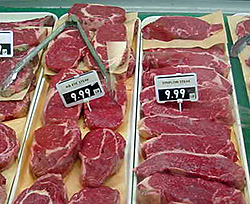Lighting Source and Perceived Meat Color in Butcher, Grocery, and Local Meat Shops

Meat color is a reflection of the wavelengths of light that are not absorbed by the meat, and is therefore a relative phenomenon determined by the spectrum emitted by the light source.
Supermarket fluorescent and LED lighting emits high levels of green and yellow wavelengths and very little of the red and blue wavelengths, which causes red lean tissue to appear brown, and white fat to look yellow or greenish.
Consumers judge the freshness of meat by its color, but many lighting sources distort true colors.
Incandescent lights are very strong in the yellow wavelengths and weaker in blue and green wavelengths, and we tend to think, erroneously, that these lamps reveal true colors.
For example, under experimental conditions, a beef steak that looked very red under incandescent lighting appeared less red under fluorescent or metal-halide lighting, while a chicken leg that appeared to be pink or red under incandescent lighting looked brown under a fluorescent lamp and purple or brown under a metal-halide lamp. Some soft white fluorescent lamps can make muscle tissue look red, but bones and fat appear pink. However, the predominance of yellow wavelengths in the spectrums of incandescent and deluxe warm white fluorescent lamps can give fat and bones a yellowish tinge, which can be very distasteful to consumers.
If meat displays do not look appealing even when the meat is blooming, consumers will not be tempted to buy, and the meat will spoil before it can be sold.
